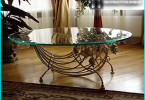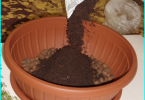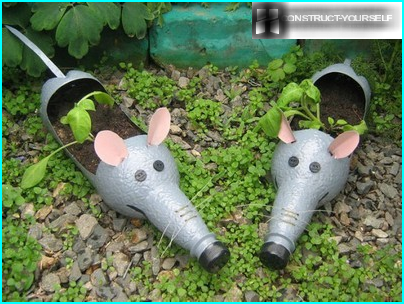
Gabions called containers, twisted metal wire, which are filled directly at the object stone or gravel. These engineering and building construction many years ago were widely used in the construction of military fortifications (redoubts). Now with the help of gabions form the shores of reservoirs, arrange a retaining wall, reinforce a slope. In addition, mesh boxes of regular geometric shape are used as decorative elements in landscape design. Generally, a gabion with his own hands made not, getting the factory mesh the right size in the right quantity. Delivered mesh containers spread on the installation site and filled with the selected bulk material. Designers already invented a lot of ideas for decorating the HOMESTEAD areas using gabion structures. Some of them can be successfully implemented on the land plot, copying what he saw the creature in the picture. A little harder to develop your project, examining the ready supply of professional landscape design.
The contents
By viewing this video, you can clearly imagine what a gabion, and also see ways to use this unique building material.
What made gabions?
Manufacturers of gabions as a starting material is used in galvanized wire, the density of the coating is 250-280 g/mTwo. This value is five times greater than the density of galvanised mesh «netting», used in the device of various barriers. Instead of galvanizing the wire can be applied PVC coating. The thickness of the coated wire is in the range of 2-6 mm. Mesh containers must have special durability achieved through the use of dual-wire torsion. The grid cells have the shape of a regular polygon. The filler is selected based on the size of the grid cells. Gabion larger sizes are supplied with additional sectional compartments, preventing the protrusion of their mesh walls at the time of loading of the filler.
Individual boxes are sealed in a single monolithic structure with wire. It is not recommended to use other types of wire, different from that from which were manufactured the gabions. Cheap analogs may lead to deformation of the structure and its premature failure.
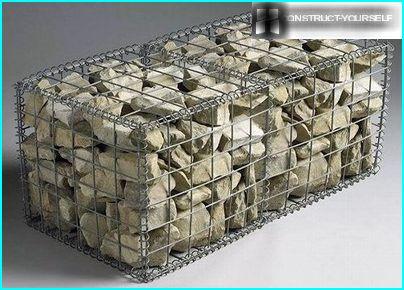
Gabion mesh consists of rectangular frame shape, filled with stone or large gravel that is larger than the dimensions of the grid cells
Here are the properties of gabions attract builders and designers:
- Flexible metal mesh walls allow the gabion to take any form of ground surface. Not afraid of gabion structure and seasonal shifts of the soil. Due to its flexible structure may be only slightly deformed at the same time, but not destroyed.
- Gabiony by stone filler have excellent permeability, so the construction is not experiencing hydrostatic pressure. During installation saves time and resources as it does not require device drains to divert water.
- The stability and durability of gabion structures over time only increases as the soil that accumulates between the stones, germinate the plants. Their roots are intertwined and further strengthen the entire structure.
- With the installation of gabions do not require heavy construction equipment (excluding large-scale projects to strengthen the shoreline and slopes), and therefore fails to preserve the natural landscape, minimizing the degree of human intervention in the ecological environment.
- The mesh structures are durable and can stand for years without being destruction. This quality is ensured by quality galvanized wire as well as the above-mentioned properties of the stone filler.
- Properly designed construction of gabions do not require any maintenance during operation.
- When using gabions manage to save money (in comparison with the concrete structures) and reduce labor costs.
The main types of gabions and their uses
In geometrical shape the gabions are divided into three types:
- box;
- flat (box-tufanye);
- cylindrical.

All the mesh structures can be divided into three main groups according to the shape of frame: round, flat, and a box that can be welded or net
Dimensions of box containers can vary in the following ranges: length 2 to 6 m, width – from one to two meters, and a height from a half meter to one meter. Structures with large dimensions complement the dividing partitions, called diaphragms. The boxes are made in two ways: welded mesh. The first method involves the welding of wire rods, arranged perpendicular to each other at their intersections. In this case cell boxes are rectangular in shape. For the connection of walls use a special wire helix. The second method (net) is based on attaching a net made of steel wire double torsion, to the rigid frame. In this case, the grid cells have a hexagonal shape.
Important! Box gabions suitable for fencing flower beds and vegetable beds. Also containers of rectangular shape can be a part of the fence. Gabions are perfectly combined with the wooden sections of the fence railings. Use boxes and with the installation of street furniture in public area.
Flat (box-tufanye) gabions with a maximum height of 30 cm, have the ability to make the same bends and surface irregularities. This type of facilities are built along the rivers, ravine slopes, is placed on the bottom of shallow ponds and streams. While the filler is usually a pebble. Flat gabions, if necessary, arrange a solid Foundation on which later established box-like structure. Underwater foundations and portions of retaining walls erected from the cylindrical gabions are able to bend in all directions.
What is the filler for the gabion will fit you?
Choose the stone for gabions, depending on the location (surface or underwater) to erect buildings. In the course are both natural and artificial stone coarse crushing. This takes into account their shape, size, composition. The most popular hard rock stones of volcanic origin: basalt, quartzite, granite, diorite. Often fill the gabions and Sandstone and other rocky rocks, characterized by high frost resistance and durability. Gabions used for decorative purposes, you can fill alternative materials: wood cut down, pieces of pipe, glass, broken tiles, bricks, paving stones, crushed concrete, etc.
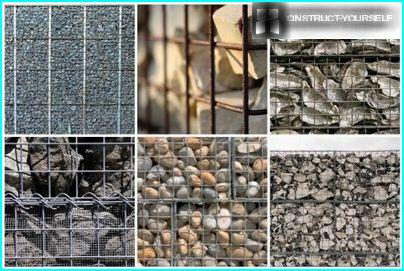
Kind, shape, size, and color used stone filler has an impact on quality decorative construction of gabions
In the regeneration of the surface of the gabions it is recommended to add a stone size fraction which is one-third greater than the length of the cell twisted wire mesh. Underwater structures are filled with an even larger stone, half exceeding the cell size of the mesh container.
Below gabion structures blend in with the local landscape, it is necessary to use for the filling of natural stone mined in local quarries. Gabion spread of rounded boulders, crushed gravel, large pebbles. In each case, the construction will look beautiful in their own way.
Important! To highlight the gabions on the site, and underscores the special texture of their walls should be laid beside them the asphalt or break a lawn. On the background of a flat surface containers, filled with stone, will look very original.
Installation of gabions all about the materials and progress of work
To build the structure of gabions will need the following materials:
- metal mesh;
- special metal spiral;
- the wire clamps;
- steel pins;
- geotextile;
- braces;
- aggregate (stones, sand, soil, debris and other loose building materials).
Before beginning installation, check the availability of supplies on the list. The lack of any element can inhibit the installation of the gabion. To connect gabion panels use staples or metal spiral, wherein the one wall is the lid and must therefore be opened. After filling it also joins the spiral to the adjacent panel. Using pins with pointed ends, the box is firmly anchored to the ground.
Filling stone metal mesh material is carried out in two stages. In a mesh container placed in layers of the stone to half its height. Then the opposite wall of the gabion by tightening the braces, to prevent the protrusions front and rear. Braces are special wire ropes. Their number depends on the length of the gabion. Braces or stiffeners are allowed every four or five grid cells. Then proceed to a second phase focusing on the further filling of the container with a rock or gravel.
Stones of large size bag bottom and front walls of the gabion. The middle container may be filled with fine gravel or even construction debris. To filling are placed between the large stones, use a geotextile. It cover the space between the stones, filling up his available material. Filling then close the top ends of the geotextile, which presses the layer of coarse gravel. After filling, cover the mesh of the container is closed and tightened with a wire spiral.
Gabion structures in pictures: design ideas
The use of gabions in the landscape design is dictated by the necessity of establishing at the site a unique reliefs. Thanks to this lightweight and durable structures, designers create flat areas hills and hollows, which are used then to split the colorful flower beds and artificial ponds, decorated with whispering waterfalls.
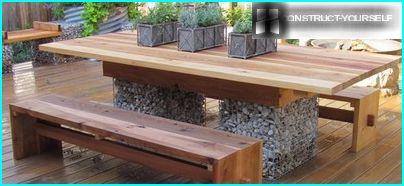
Gabion box used for the manufacture of garden furniture, in perfect harmony with the wood that made the table top and two benches

Another option is the use of gabion complex form in the manufacture of garden furniture available on the site in the area
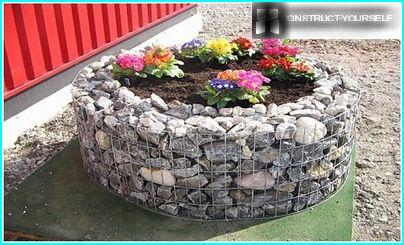
Gabion a cylindrical shape acts as unusual fences flower beds. The background stone filler delicate flowers of rich colors look especially nice
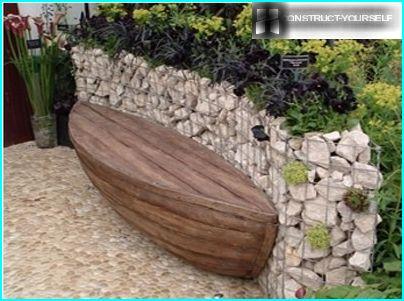
Retaining wall made of gabion curved shape, in which design is integrated bench in the form of boats for leisure and the contemplation of the beauties of the garden
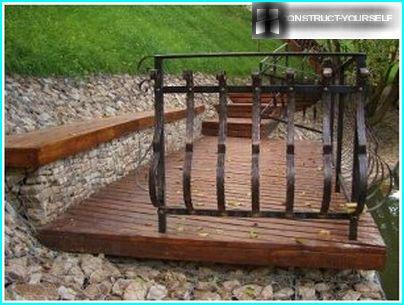
The use of gabions in the design of the shoreline of the reservoir, located on the estate. Wood, stone and wrought-iron railing perfectly complement each other
Any land can be turned into a fabulous garden that brings joy and peace. It will have to work by yourself or invite the professional designers who know how to make and install gabion and how to fill it.

